Black and white bees live in various parts of the US. They are part of various species from honey-making bees to kleptoparasitic bees.
Black and white coloring are atypical in the world of bees which are mostly known for being black and yellow.
However, black and white color combinations make bees stand out and even look similar between the species.
Most black and white bees are dominantly-black. Some only have white hairs on the thorax or the abdomen.
Other bees have a more balanced black and white representation, mainly in the form of alternating black and white bands.
These bands are mostly seen on the abdomen but they can also be visible on the thorax of certain bee species.
Many types of black and white bees have made their way to the US from Europe.
For example, Slender-faced Masked bees have been first discovered in 1913 in North Dakota.
Like other imported species, these bees have spread around the US.
Black and white bees are now found from California to Florida and further north to Canada.
Table of Contents
Are Black and White Bees Dangerous?
Bees that are black and white can sometimes sting. They prefer to sting when threatened.
Most black and white bees don’t sting, however. Bees of this color combination tend to live solitary lives and they rarely interact with humans.
Even kleptoparasitic bees might deter from stinging people if not roughly handled.
Black and white bees are normally only aggressive when it comes to territorial male disputes.
Some of these male bees have their protected territories where only females are allowed.
Types of Black and White Bees
1. California Digger-cuckoo Bee
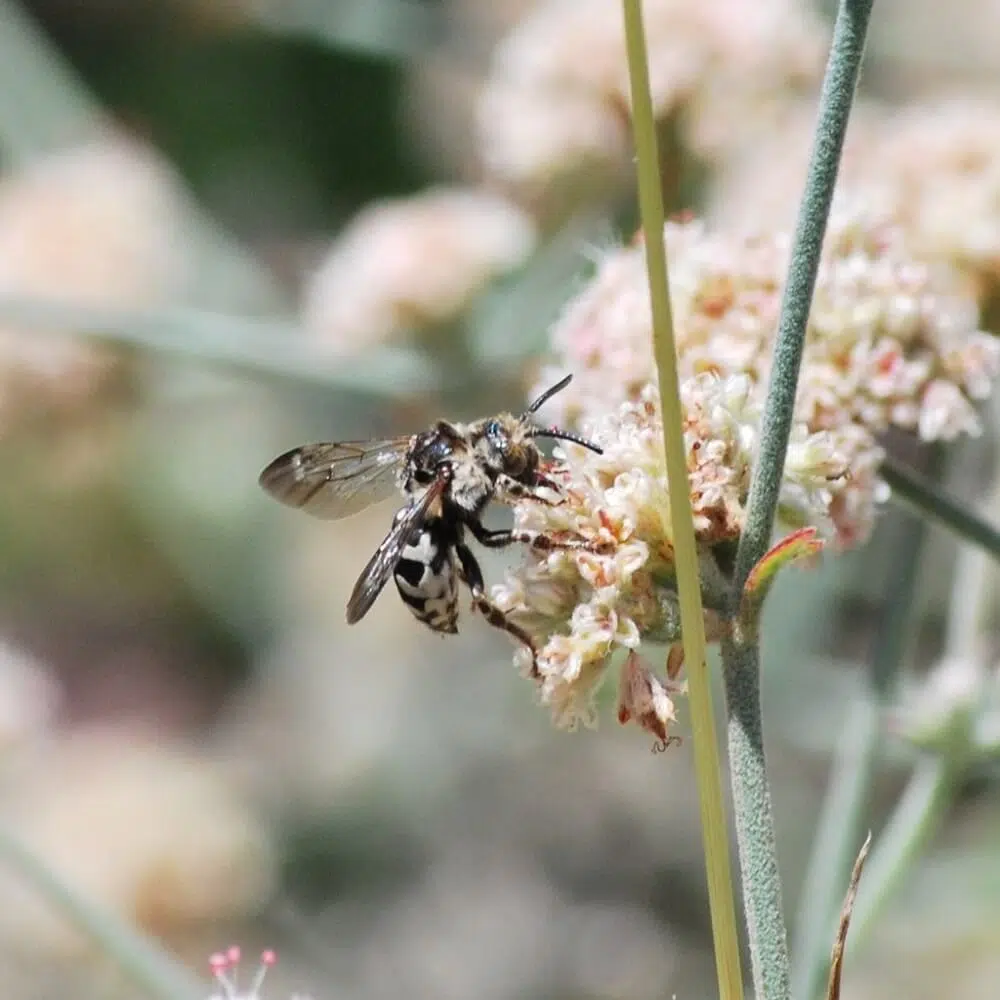
California Digger-cuckoo bee (Brachymelecta californica) is one of the most common black and white species in the US.
These bees have once been believed to be very rare, but their presence is now confirmed as very established.
Bees of this genus have a black cephalothorax and a black abdomen.
White hairs are visible on its cephalothorax while the abdomen has white horizontal bands interrupted in the middle.
The antennae, wings, and legs of the species are also black.
2. Eight-toothed Cuckoo Leaf-cutter Bee
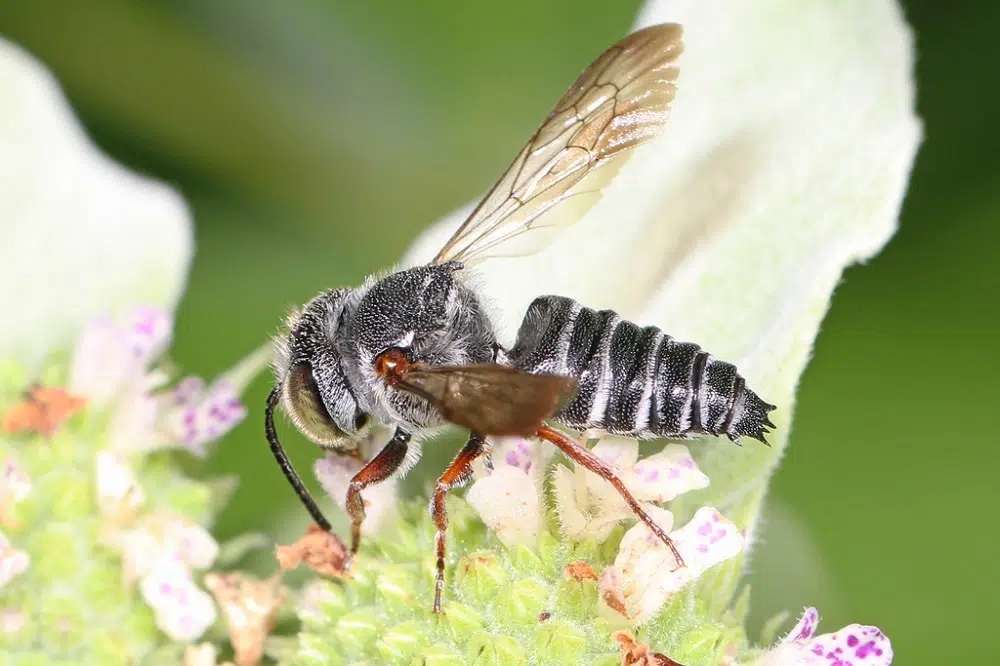
Similar to the California Digger-cuckoo bee, the Eight-toothed Cuckoo Leaf-cutter bee (Coelioxys octodentatus) has a black and white body.
Its abdomen shows white bands while its cephalothorax has short white hairs.
Unlike the California Digger-cuckoo bee, the Eight-toothed Cuckoo Leaf-cutter bee has brown-red legs and brown-red wings.
The species is kleptoparasitic as it lays eggs in the nest of other bees.
3. Texas Leaf-cutter Bee
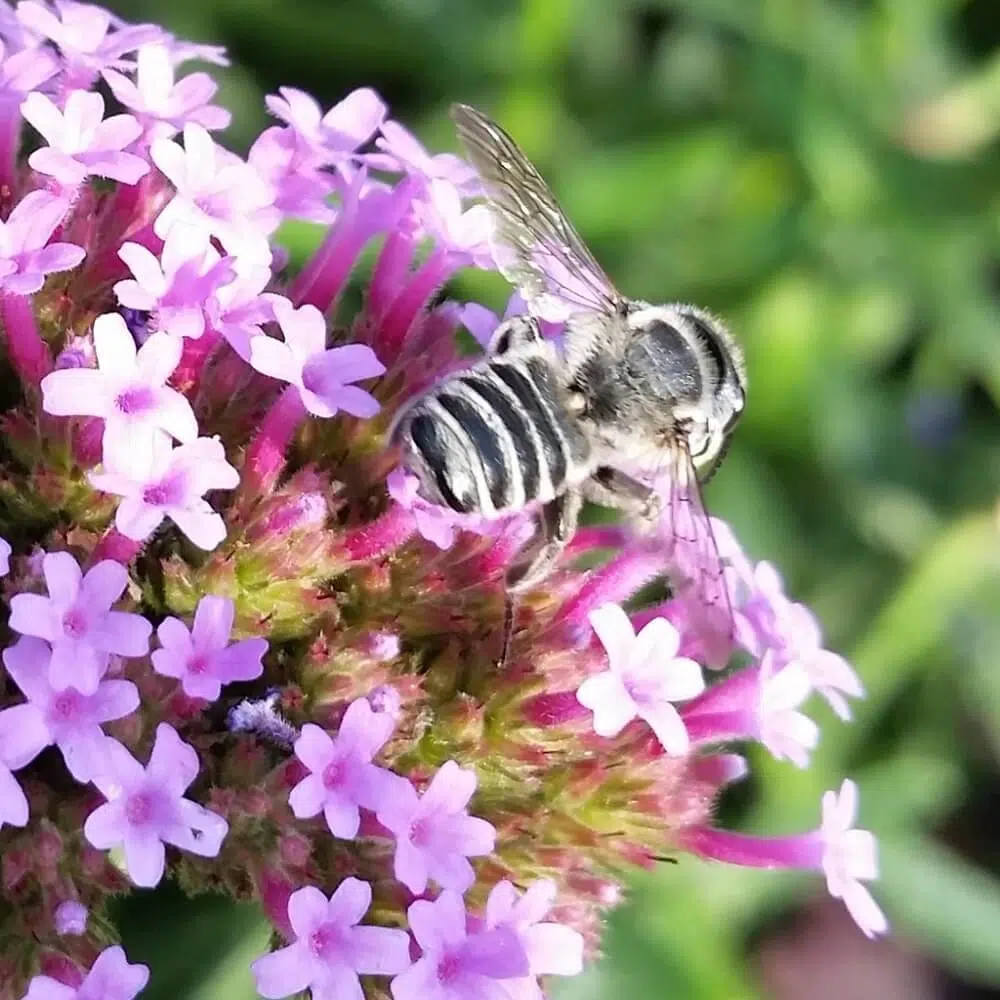
Texas Leaf-cutter bees (Megachile texana) have a black and white body and grow to a maximum size of 13mm.
A black body with white bands and white hairs is specific to the species.
Some Texas leaf-cutter bees also have yellow hairs on the abdomen.
The wings of the bees are yellow-brown.
These bees nest in existing cavities but can also dig their own nest in the absence of a suitable nesting location.
4. Bellflower Resin Bee
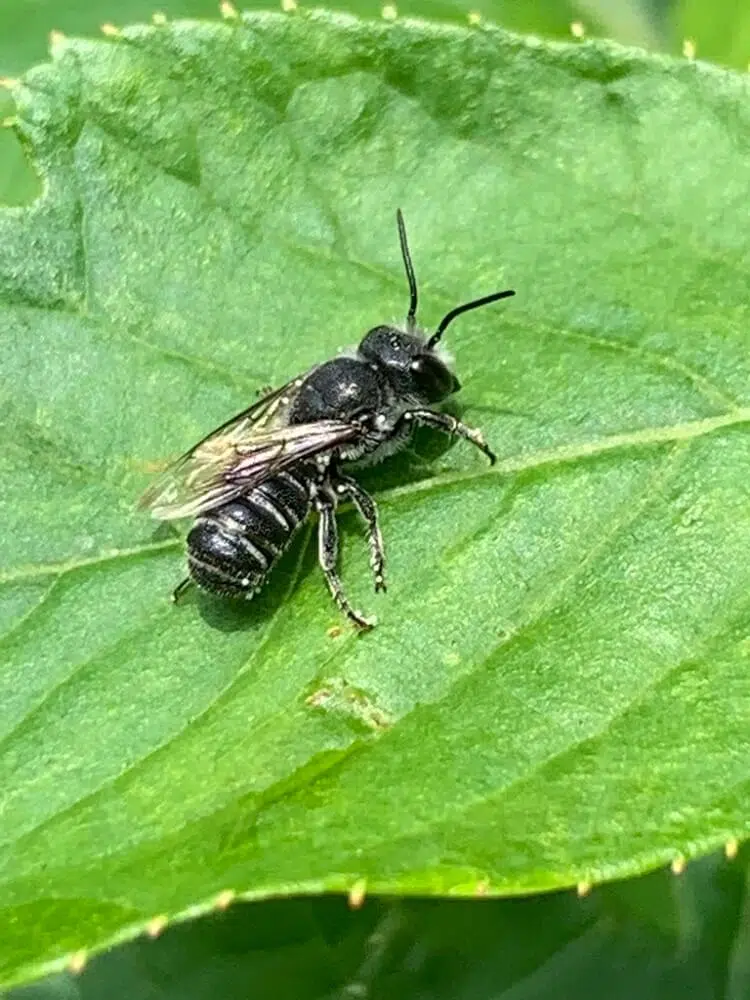
Bellflower Resin bees (Megachile campanulae) have a black color. These bees additionally exhibit white bands and white hairs.
Females of the genus also have yellow bands next to the white bands on the abdomen.
Most importantly, Bellflower Resin bees are widely known for using synthetic materials to build their nests.
Most bees use organic materials in nest building.
Caulk is one of the synthetic materials Bellflower Resin bees use to make nests.
5. Orange-tipped Woodborer

Black and white are the main colors of the Orange-tipped Woodborer (Lithurgopsis apicalis).
Bees of the species have orange legs and orange antennae.
Orange-tipped Woodborers are bees that make their nests in wood.
Bees of this genus are excellent wood borers as they can make nests in soft and firm wood alike.
6. Parallel-striped Sweat Bee

These bees (Halictus parallelus) get their name from the parallel white lines on their black abdomen.
Bees of the genus have a black body with red-brown legs.
They grow to a maximum size of 13mm in the case of females and 8mm in the case of males.
Common in Florida, these bees have a long flight season that lasts until November.
Their flight season is shorter in Northern habitats such as those in New Jersey.
7. Common Longhorn Bee
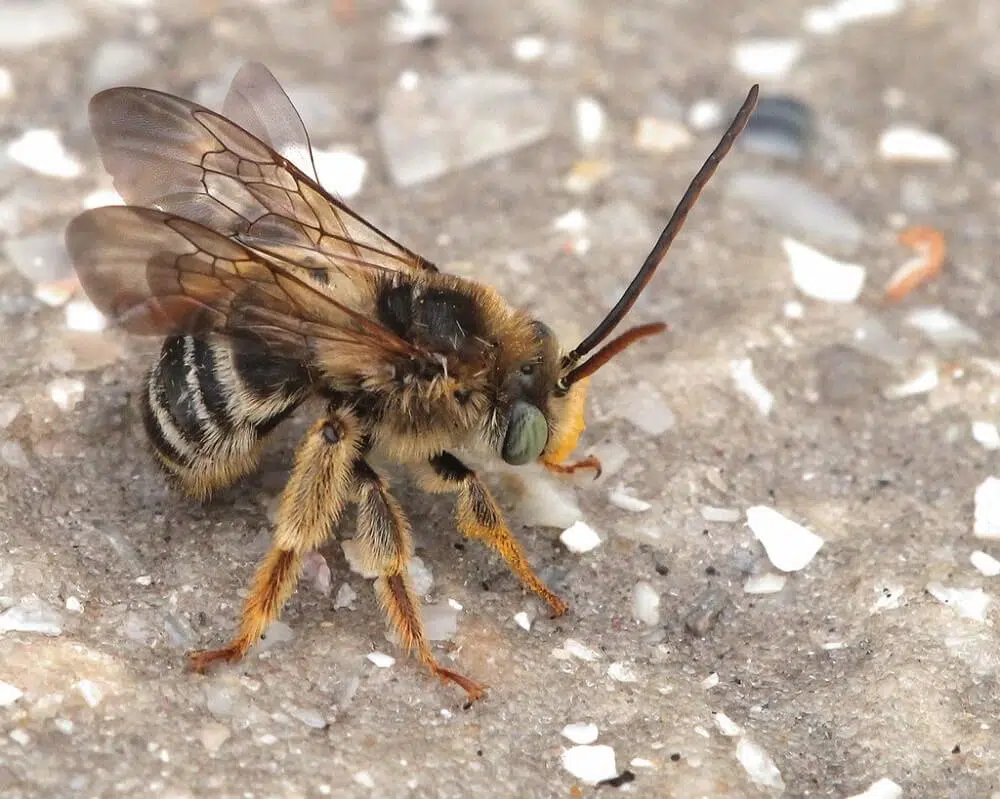
The Common Longhorn bee (Melissodes communis) has a black and white body. It also exhibits dark yellow patches on its body.
Bees of this genus are found all around the US. This includes Northern states.
Common Longhorn bees are excellent pollinators of Proboscidea louisianica. They have a beneficial role in the pollination of other wildflowers as well.
Correctly identifying this species also involves assessing its size since black, white, and yellow coloring is also specific to other species.
Common Longhorn bees’ average size of around 12mm but they can be as large as 15mm.
These bees burrow in the ground where up to 11 eggs are laid in the same nest.
Common Longhorn bees always lay at least 7 eggs in the same nest.
8. Melissodes denticulatus
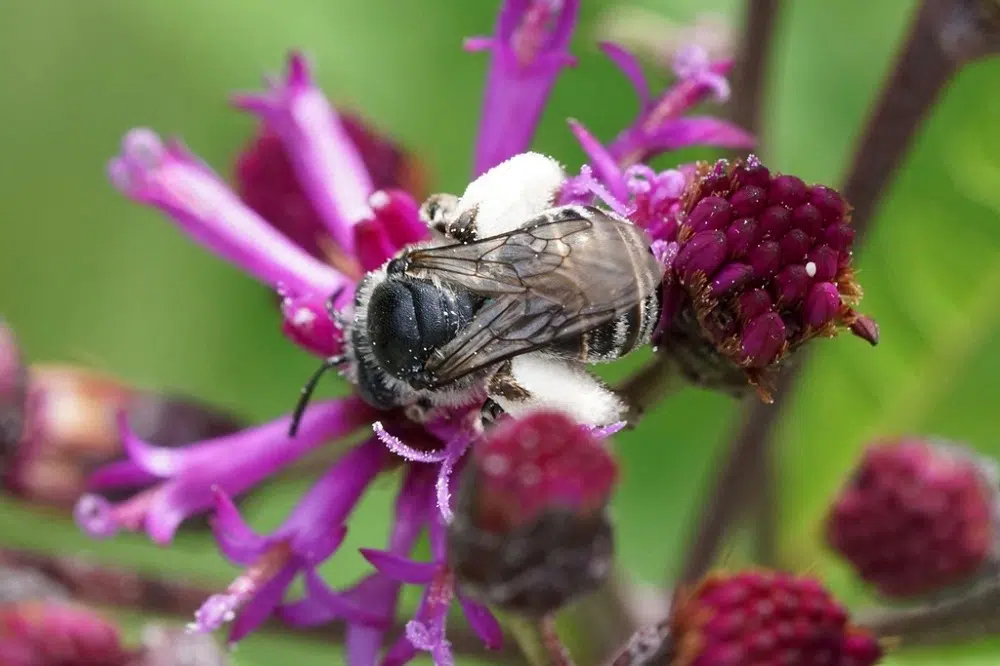
Common in the Eastern half of the US, these bees have a black body with white hairy bands. The bands on its lower abdomen are wider than those on its upper abdomen.
White hairs are seen on the rest of the body as well.
These bees are mostly seen visiting asters. Verbena is another plant species where these bees are often seen.
Both males and females are seen around these flowers.
Females are identified by their larger bodies as they grow to 13mm while males grow to 11mm.
9. Hoary Leafcutter Bee

These bees (Megachile pruina) have a shiny black body with white hairs and bands on the abdomen. Yellow hairs are distinguished on its head.
The ventral side of these bees is where long white hairs can be spotted. These hairs help the bee collect and carry pollen.
The species is relatively newly described in the US. Some of its first mentions date back to 1937 while other black bees are mentioned sooner.
Hoary Leafcutter bees are prominent in Eastern US states such as Florida and New Jersey.
10. Leathery Sweat Bee
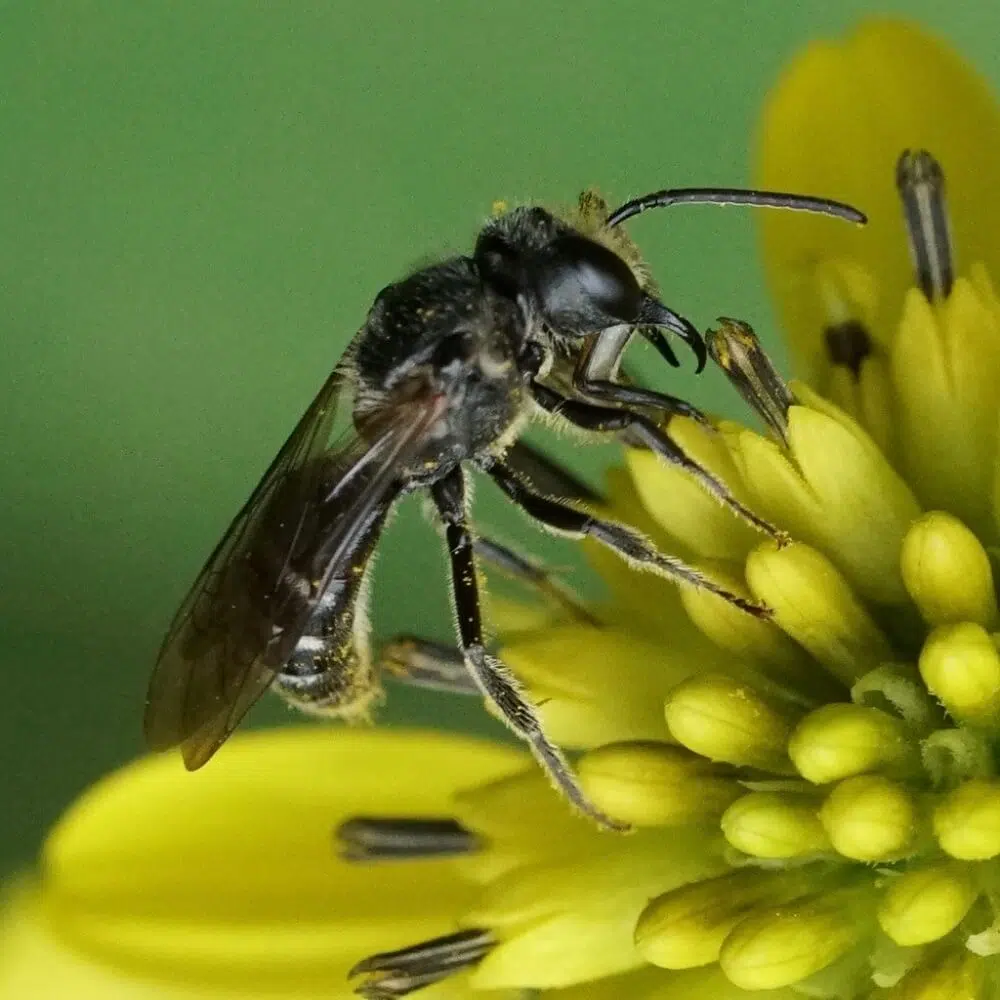
Known for visiting asters and following sweaty people, Leathery Sweat bees (Lasioglossum coriaceum) are highly present in the US.
Bees of this genus are dominated by a black background color.
White bands are present on Leathery Sweat bees, mostly on the lower abdomen.
The wings are brown to dark brown, similar to the hairs on the cephalothorax.
The Northeastern parts of the US are where you can find most Leathery Sweat bees.
11. Spine-shouldered Cellophane Bee
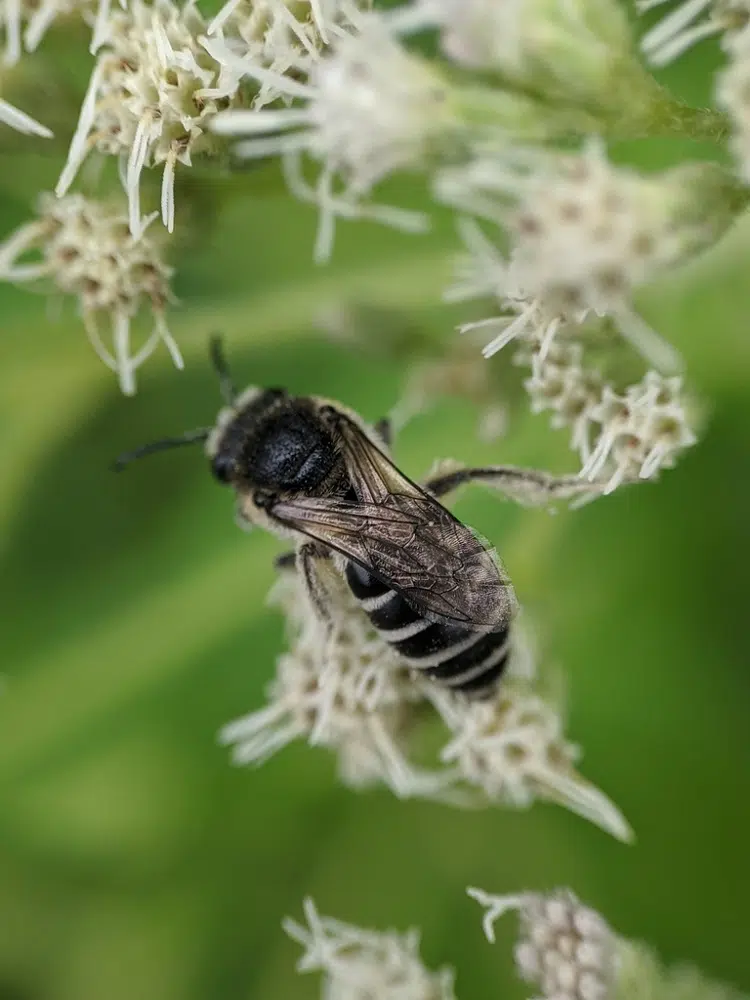
Spine-shouldered Cellophane bees (Colletes simulans) are native to the US.
They can be found both in Northern and Southern states and are identified by their black bodies with white bands across the abdomen.
These bees burrow their nests in the ground. These nests are then lined with a protective membrane similar to cellophane.
Spine-shouldered Cellophane bees visit multiple flowers per hour. They mainly collect pollen from flowers such as asters.
Growing to a size of up to 11.5mm, these bees are agile and they have a long flight season.
Spine-shouldered Cellophane bees remain active until November in Southern states.
12. Morning Glory Turret Bee
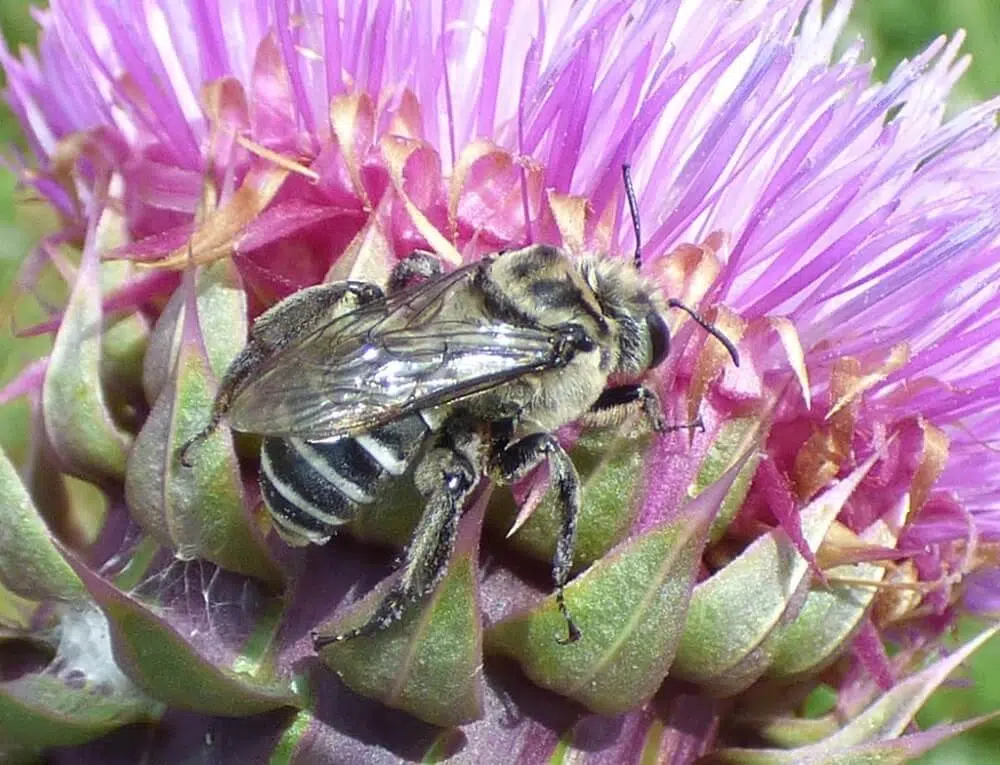
Morning Glory Turret bees (Melitoma taurea) are found in areas of use with Morning glory flowers.
These bees have atypical white bands on a black body as they have them both on the abdomen and the cephalothorax.
Bees of the genus also exhibit white hairs on the cephalothorax and the ventral side.
Morning Glory Turret bees are known for building individual nests in the ground.
These nests have mud constructions similar to chimneys on the surface. It allows bees to guard the nest while also being sheltered by the nest.
13. Florida Longhorn-Cuckoo
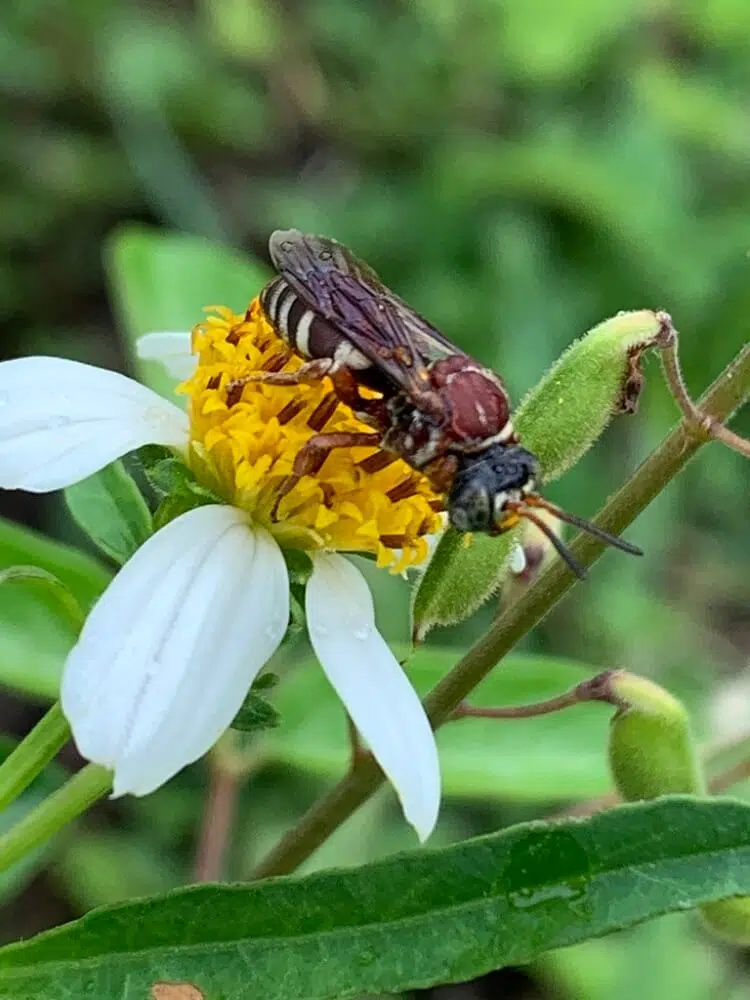
This species (Triepeolus rufithorax) has a brown cephalothorax and a white and black abdomen. Its legs are brown while its antennae are black.
Native to the US, this species also has metallic green or metallic blue colored black patches on its head.
Florida Longhorn-Cuckoo bees also come in brown and yellow coloring.
These bees have almost no hairs on their bodies which mean many people take them for wasps and kill them.
Spanish needles are among the favorite flowers of the Florida Longhorn-Cuckoos.
14. Tepanec Long-horned Bee
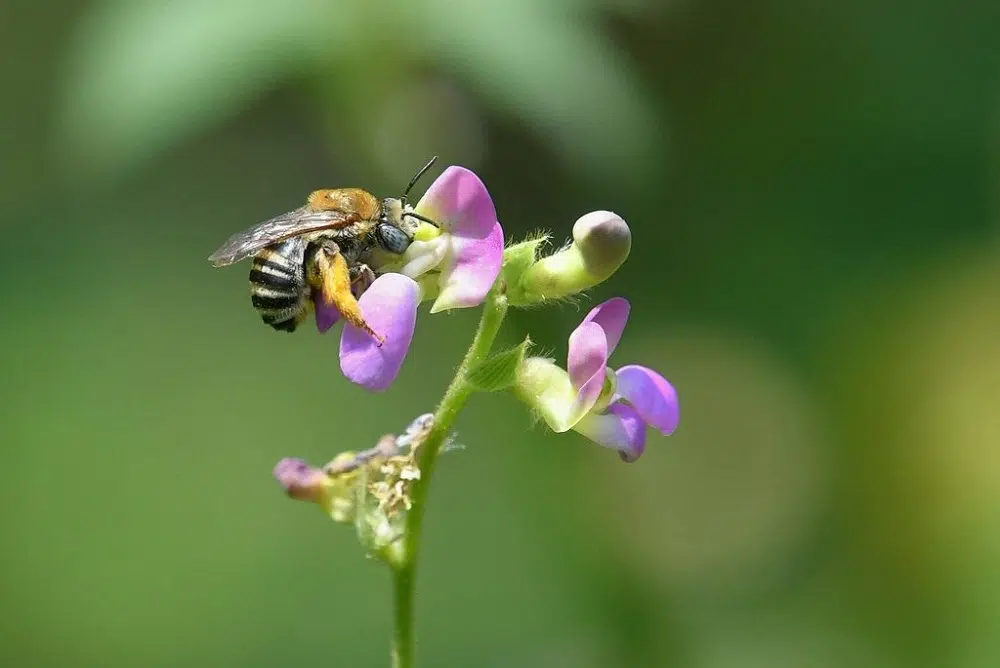
These bees (Melissodes tepaneca) have a black body and white hairs on the rear legs in the case of females.
Males have a black body with yellow hairs and yellow bands on the abdomen.
These bees are common in Southern states where they visit a large number of flowers and vegetables.
Tepanec Long-horned bees visit milkweed often but they are also seen on various flowering cacti.
These bees are one of the 3 subspecies found in the US.
All of these subspecies are named after their exceptionally-long antennae.
15. Nason’s Mining Bee

White and black are the main colors of this tricolored bee species (Andrena nasonii). Its wings are rusty-brown but the main color of the species is black.
White hairs and bands are visible across its body.
The ventral long white hair of the bees helps them carry more pollen.
Common in North America and Central America, Nason’s Mining bee has a short flight season up until mid-summer.
16. Red-footed Cuckoo Leafcutter
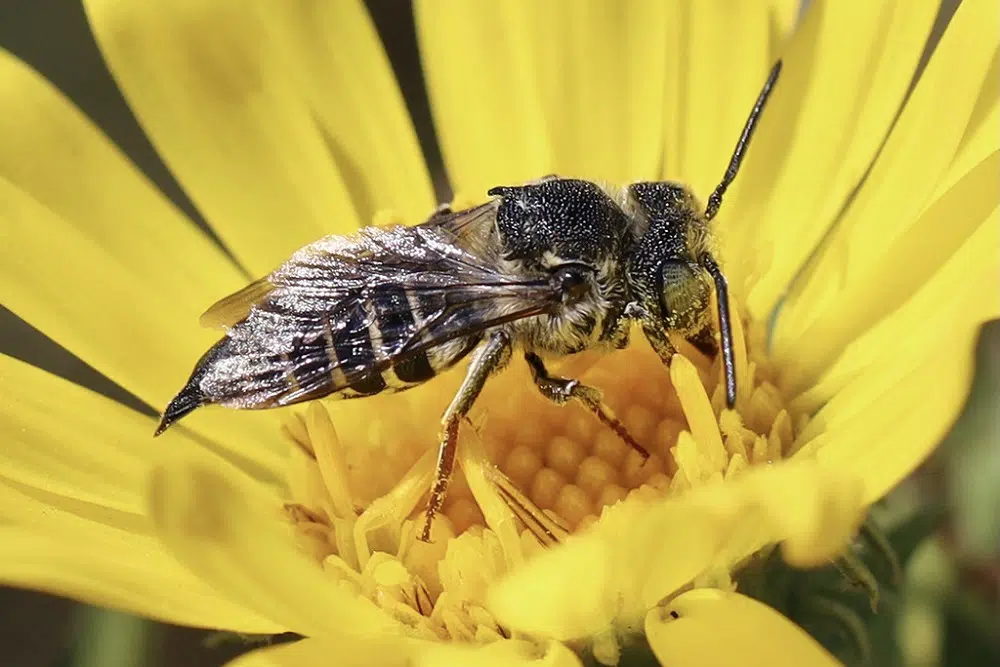
These bees (Coelioxys rufitarsis) have a long body of up to 20mm.
It has a black body with white stripes and white hair.
As its name implies, this cuckoo bee is kleptoparasitic. It uses the nests of species such as the Broad-handed leafcutter.
It enters the nest of the host bee species and kills the host and its eggs before settling in.
Red-footed Cockoo Leafcutters continue their kleptoparasitic behavior until October to emerge in May the following year.
17. Pugnacious Leafcutter Bee

The Pungnacious Leafcutter bees (Megachile pugnata) have a black color and either yellow or white banding in-between abdominal segments.
Bees of this genus have multiple abdominal segments separated by long colored hairs but which look different from females to males.
Females have yellow hairs between abdominal segments while males have white hairs between abdominal segments.
Both males and females have contrasting transparent brown wings.
Females Pugnacious Leafcutter bees have atypical large mandibles they can chew fibers with.
Males don’t have large mandibles.
18. Waroon Cloak-and-dagger Bee

Waroon Cloak-and-dagger bees (Thyreus waroonensis) are among the few species of bees that are mostly white. Black is the secondary color of the bee as black marks are barely visible on the cephalothorax and the abdomen.
Black color is dominant on the ventral side of Waroon Cloak-and-dagger bees.
These bees are known to be parasitic. They are a parasite of Amegilla bees.
However, the high reproductive rates of Amegilla bees stop Waroon Cloak-and-dagger bees from being seen as a major threat to the species.
19. Grey-backed Mining Bee

Grey-backed Mining bees (Andrena vaga) get their name from the gray or white hairs they have on their black bodies.
White hairs are seen on the thorax of the species both in males and females.
Native to Europe, the species is among the bees that suffer from parasitic bee invasions.
Gray-backed Mining bees are still very efficient in maintaining their solitary life safe.
Part of this efficiency is based on an organized flower-visiting schedule.
Gray-backed Mining bees have certain days for collecting pollen and other days for collecting nectar.
20. Ashy Mining Bee

These black bees (Andrena cineraria) have wide white bands on the thorax and the abdomen.
White hairs on these bees can also appear gray in some cases.
Bees of the genus are known as friendly. There are no recorded cases of stinging Ashy Mining bees without being roughly handled.
Ashy Mining bees are among the few black and white bees that live together. Communal living is the norm for these bees who don’t live solitary lives.
Multiple bees can live in deep underground burrows.
These burrows are built by chambers so that larvae and adult bees can be separated.
21. Megachile apicalis

Common in Europe, this species has been reported in North America.
Large eyes, a black uniform color, and multiple white abdominal bands characterize the look of these bees.
The habitat of the species is mainly tied to the Mediterranean. However, bees of the genus are widespread in Northern US states.
They are mostly present in coastal states both on the Atlantic and the Pacific Coast.
22. Sumac Cellophane-Cuckoo

Sumac Cellophane-Cuckoos (Epeolus lectoides) are black bees with white bands interrupted on the central dorsal area.
Bees of this genus have very long antennae but are mainly known for their kleptoparasitic behavior.
Sumac Cellophane-Cuckoo bees are parasites of bees in the genus of Colletes.
Both Colletes and Epeolus bees line their burrows with cellophane-like waterproof membranes.
Sumac Cellophane-Cuckoo bees kill the eggs of their host bees and they eat the pollen adult bees have deposited for their broad.
23. Broad-footed Cellophane Bee
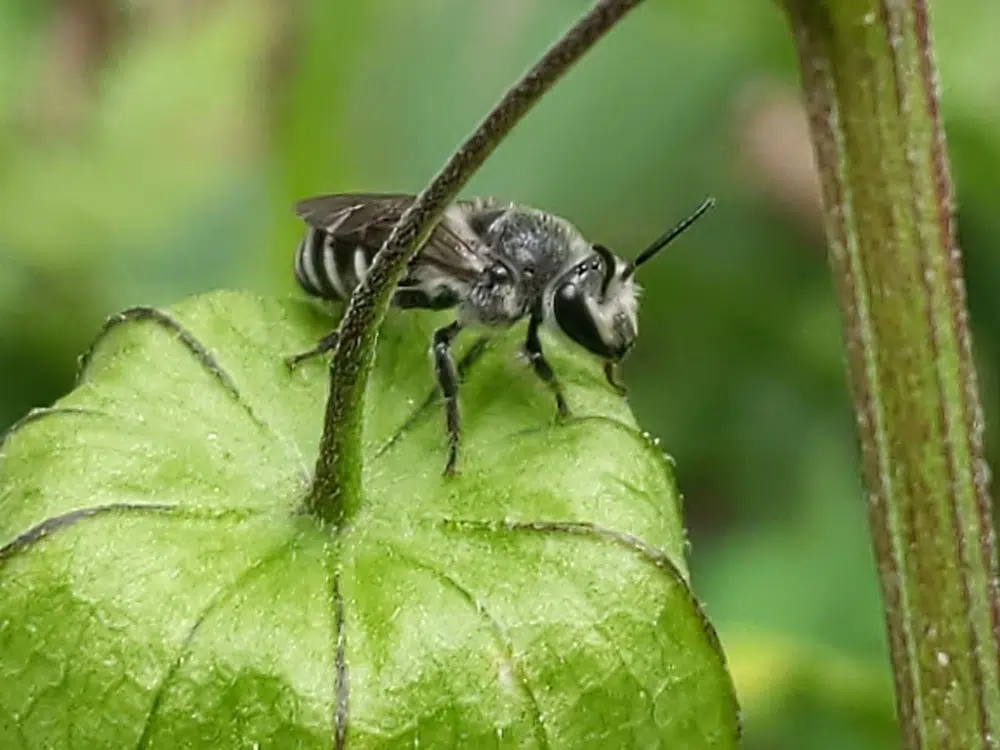
With a late flight season debuting in July, Broad-footed Cellophane bees (Colletes latitarsis) have a black body with white bands and black wings.
These bees are known to have gray-white hairs across the body.
They live on the ground but the solitary nature of the bees makes it difficult to establish the number of burrows located in one place.
Male territorial claims might also be responsible for highly solitary bees of this genus.
Most males patrol an area with flowers where they only allow females to enter, mainly for mating.
24. Verbesina Longhorn-Cuckoo
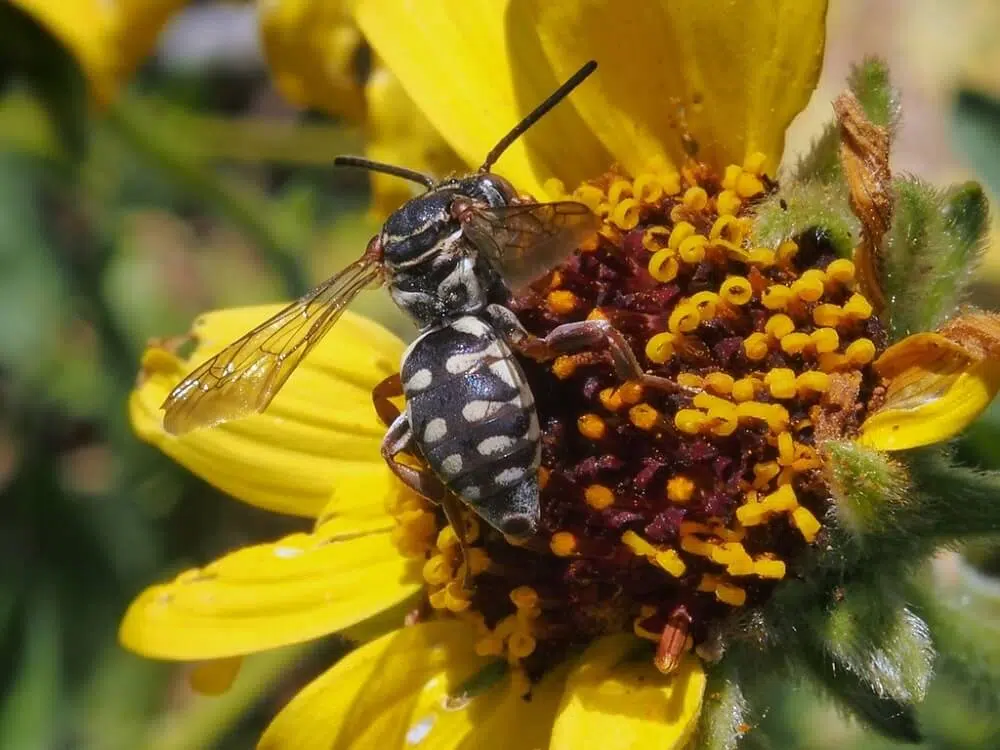
These bees (Triepeolus verbesinae) are native to North and Central America.
Verbesina Longhorn-Cuckoo bees grow up to 0.5 inches in the case of females.
They are identified by a black body with white interrupted bands on the abdomen and a circular-shaped white margin on the thorax.
These bees don’t have any hairs or sufficiently-long hairs. They mainly feed on the nectar of various plants.
25. Slender-faced Masked Bee
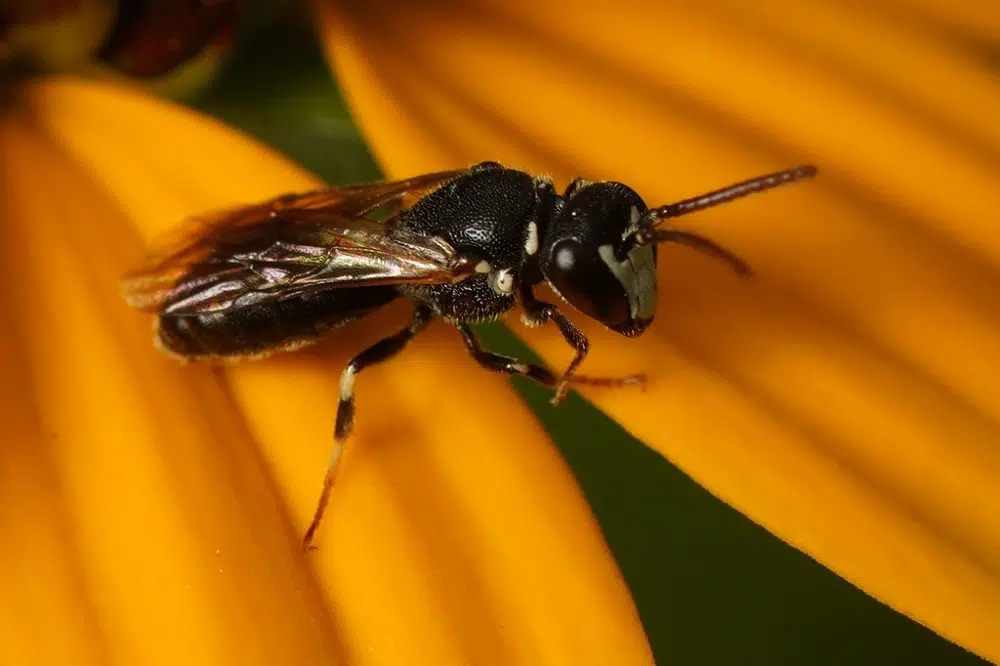
Early literature shows that Slender-faced Masked bees (Hylaeus leptocephalus) made their way to North America in 1913 for the first time.
This is the year these bees have arrived on the continent and spread around multiple states.
While most Slender-faced Masked bees live in North Dakota, they are now found in most US states.
Black, yellow, and white coloring is specific to these bees.
Black is the main color of the bees with white and yellow bands on the thorax and the abdomen. The wings of the species are either brown or black.
26. Indian Epaulette-Nomia
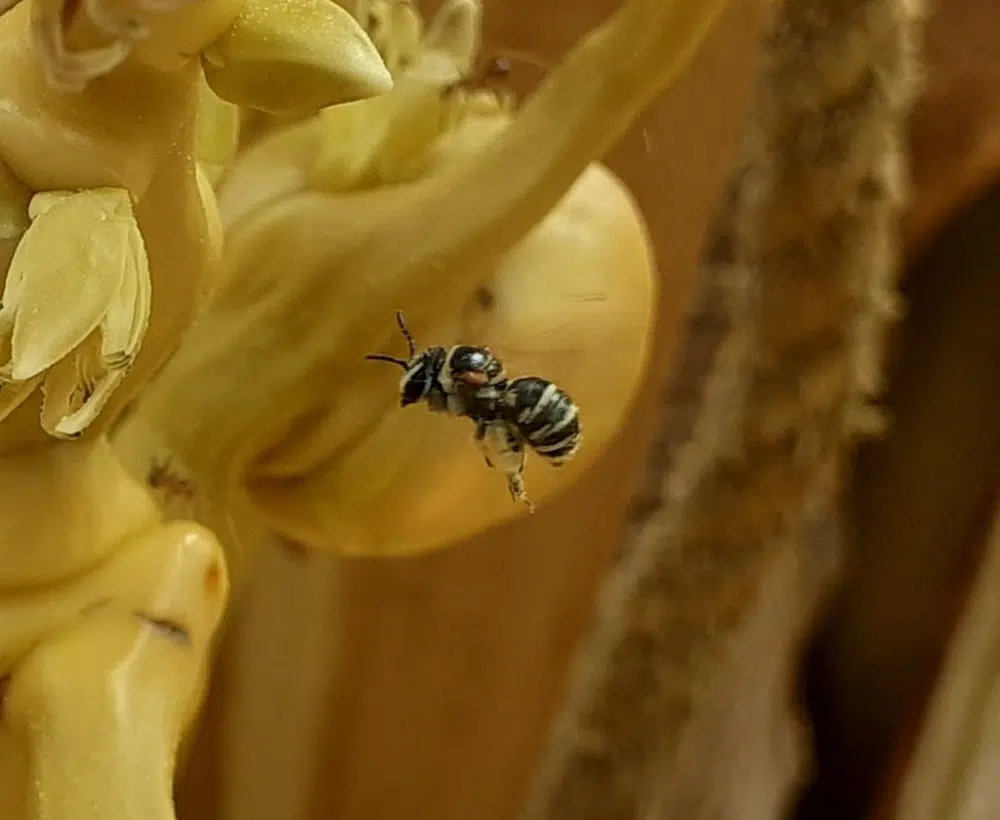
The India Epaulette-Nomia (Pseudapis oxybeloides) is a bee species common in Asia, and Europe. India is where these bees are prominent.
The species has also been discovered in Africa.
A known pollinator, Indian Epaulette-Nomia has a balanced percentage of white and black coloring on the body.
The entire body is colored by alternating white and black bands. The bees have transparent black wings.
Bees of this genus have been studied for their role in the pollination of crops. Their role in agriculture is increasing as the bees spread throughout the world.
More than 20 plant species can be visited on a single crop by the Indian Epaulette-Nomia bee.
Further Reading: